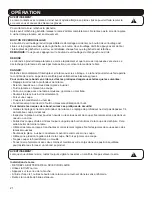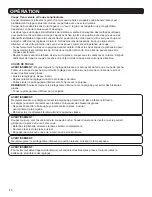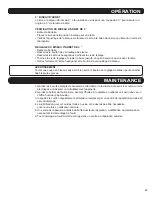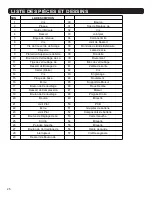
10
OPERATION
Cross-Cutting and Rip Cutting
Cutting directly across the grain of a piece of wood is called crosscutting
and is likely the most common type of cut done with a circular saw.
Cutting wood lengthwise, or “with” the grain, is called rip cutting. However,
it’s most often referred to simply as ripping.
Both types of cuts are performed in the same manner with the exception of
the methods used to support and secure the work piece for cutting. After you
have secured the work piece in position with clamps or similar devices,
prepared the work area, positioned the cord so it won’t be cut or become
hung up, performed the saw set up adjustments, made the necessary
measurements, drawn a straight guideline, and put on your eye protection,
you can begin the cutting operation.
• Hold the tool firmly using both the front grip and rear handle
. Use both
gripping areas to best hold and control the saw. If both hands are holding
the saw, they cannot be cut by the blade.
• Set the front portion of the saw
’s base on the work piece to be cut without
the blade making any contact. Align the line-of-cut indicator notch on the right
side of the base with your guideline.
POCKET CUTTING
WARNING:
Always adjust bevel setting to zero before making a pocket cut. Attempting a
pocket cut at any other setting can result in loss of control of the saw possibly
causing serious injury.
• Adjust the bevel setting to zero.
• Set the blade to the correct blade depth setting.
• Swing the lower blade guard up using the lower blade guard handle.10 English
NOTE:
Always raise the lower blade guard with the handle to avoid serious injury.
• Hold the lower blade guard by the handle.
WARNING:
Never extend your fingers while holding the lower blade guard handle. Extending
your fingers could result in contact with the blade, causing serious injury.
• Rest the front of the base flat against the workpiece with the rear of the handle
raised so the blade does not touch the workpiece.
• Start the saw and let the blade reach full speed.
• Guide the saw into the workpiece and make the cut.
WARNING:
Always cut in a forward direction when pocket cutting. Cutting in the reverse
direction could cause the saw to climb up on the workpiece and back toward you.
• Release the trigger and allow the blade to come to a complete stop.
• Lift the saw from the workpiece.
• Clear corners out with a hand saw or sabre saw.
WARNING:
Never tie the lower blade guard in a raised position. Leaving the blade exposed
could lead to serious injury.
!
!
!











































